15 February – 31 March, 2020
Hello SeasonWatch supporter,
We organized SeasonWatch Spring Festival, our first event for this year, between mid-February and end of March. This time of the year is especially important for several species that flower as the cold dry seasons recedes. Since, many of these species have been reporting early flowering, the idea of a long event was to capture this aberrant flowering (e.g., Butea monsperma, Rhododendron arboreum). Some of our important festivals that fall during this time also have cultural association with trees (e.g, Holi with Palash or Butea monosperma and Ugadi with Neem or Azadirachta indica) and so we were also hoping to look at tree phenology with respect to known cultural baselines.
Unfortunately, this is also the time when our world is experiencing a COVID-19 disease outbreak. We hope that all our contributors are safe and healthy. We are grateful to those of you who have been keeping a keen eye on the trees around, and we hope that you are doing so from the safety of your homes and by following the necessary guidelines to protect yourselves and those around you. While we are all learning to manage and improve our present situation, we bring you this newsletter in an attempt to finish and summarize what we all started together.
During the Spring Festival, 72 individuals, 49 schools and colleges contributed 7872 observations from the country. As always, Kerala contributed more observations than any other state, and Mango and Jackfruit trees continue to be favourites among tree-watchers.
Considering the present situation, we will not be be organizing any events or challenges in the coming weeks but we can all continue to watch trees from our homes. We are hoping to organize some webinars and talks around trees. More on in this in the coming days.
Thanks you for your support and stay safe.
Sincerely,
SeasonWatch Team
Observations
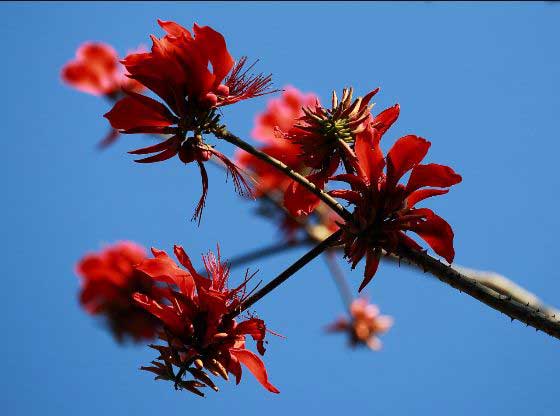
Indian coral, Erythrina indica, observed by Surendhar Boobalan during the Spring Festival.
Top 10 Species
This Festival, 128 species were observed and the top species was Mango, followed by Jackfruit and Indian laburnum. All India, top ten species were as follows:
| Species | Trees |
|---|---|
| Mango (all varieties)- Mangifera indica | 1233 |
| Jackfruit- Artocarpus heterophyllus | 648 |
| Indian laburnum- Cassia fistula | 556 |
| Teak- Tectona grandis | 343 |
| Rain tree- Samanea saman | 325 |
| Neem- Azadirachta indica | 269 |
| Red silk-cotton- Bombax ceiba | 225 |
| Gulmohur- Delonix regia | 223 |
| Tamarind- Tamarindus indica | 193 |
| Copperpod- Peltophorum pterocarpum | 180 |
Top 10 States
Most number of observations came from the following 10 states. Over 80% of all observations came from Kerala alone!
| State | No. of observations |
|---|---|
| Kerala | 6377 |
| Tamil Nadu | 652 |
| Puducherry | 196 |
| Karnataka | 149 |
| Madhya Pradesh | 146 |
| Meghalaya | 88 |
| Maharashtra | 66 |
| Odisha | 59 |
| Rajasthan | 57 |
| Delhi | 28 |
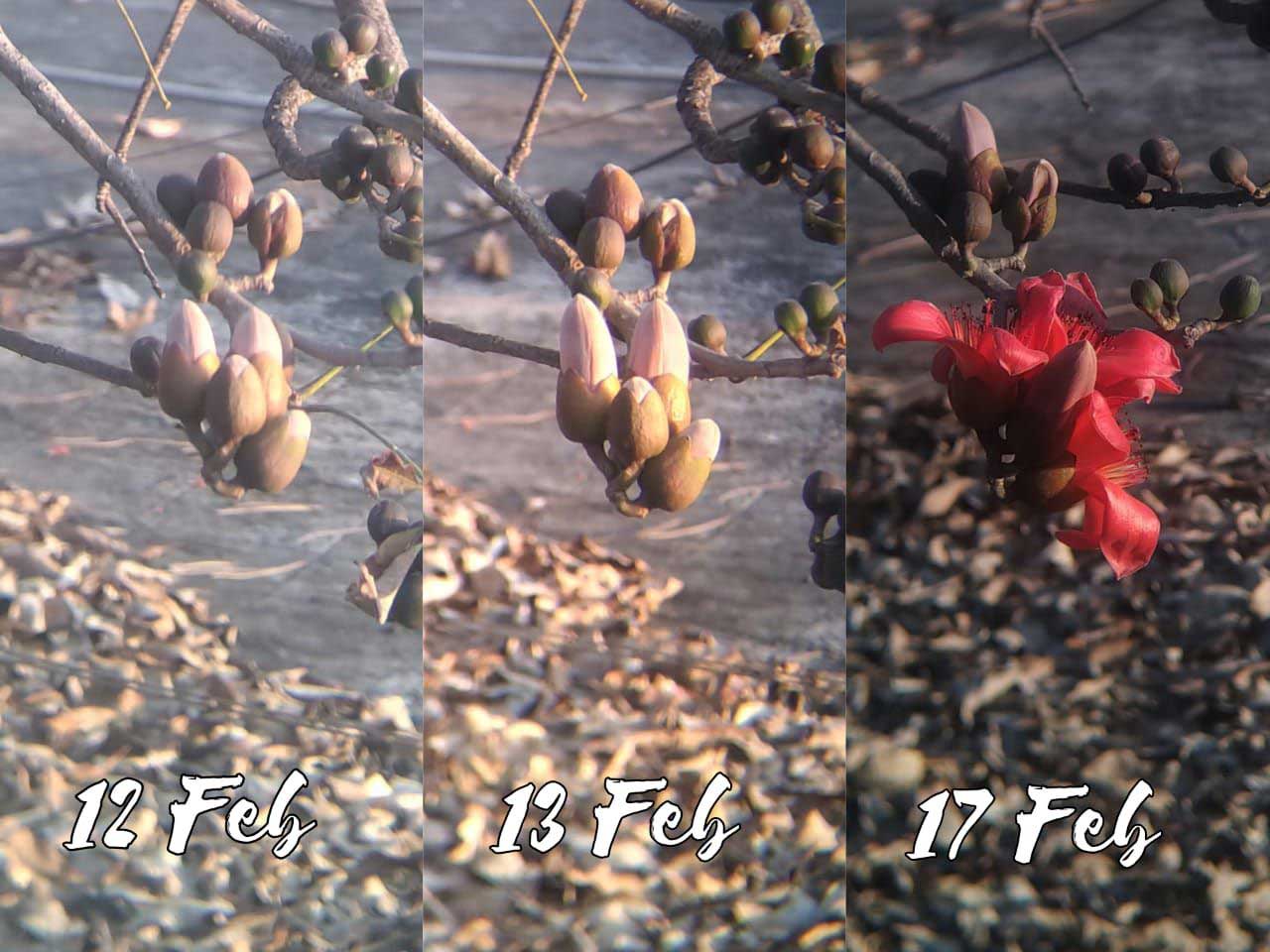
Red silk cotton, Bombax ceiba, observed by Rajarajan Vetriselvan before and during the Spring Festival.
Contributors
We are very thankful to all the individuals, schools and colleges who participated in the Spring Festival. Our challenge during this event was to either upload at least four regular observation on a registered tree of any species from the SeasonWatch list of trees, or to observe 20 trees of the following species: Rain tree (Samanea saman), Indian laburnum (Cassia fistula), Indian coral (Erythrina indica), Red silk cotton (Bombax ceiba), Gulmohur (Delonix regia), or Mango (Mangifera indica). We selected one individual and one school as lucky draw winners (highlighted in blue, boldface text below). Congratulation to the winners! Here is a list of everyone who participated (and the number of trees they observed):
Schools:
Aiswarya Public School (7), Amrita Vidyalayam (4), Amrita Vidyalayam Kodungallur (6), Amrith Vidyalayam- (500), Anderson HSS (30), Arun School Aariyur (8), AUPS Payyanadam-Pallikkunnu (2), Bemannur GUPS- Paruthippulli (182), Bhavans Vidya Mandir Elamakkara (1), Blossoms English School (511), Chintan (1), CPNM GHSS Mathamangalam (773), Dr. N. International School (5), Edakkarakolakkad AUPS (14), Eriam Vidyamithram UP School (32), GHS Kalichanadukkam (5), GJHS Naduvattam (10), GLPS Chengaloor (3), Government Higher Secondary School (30), Govt Higher Secondary School (53), Govt HSS Karunagappally (7), Govt UPS Edavilakom (Visishta Haritha Vidyalayam) (194), Govt V H S S Veeranakavu (855), Govt UP School Kayanna (1), GUPS Kongad (1), IGGHS- Katterikuppam (10), Jawahar Navodaya Vidyalaya (27), Kizhuthally East U P School (25), KKPMUPS Varinjam (243), MTSSKGUP School (318), Madona LP School (2), Maee (3), Mahua Ghara (2), Mavilayi UP School (1), Our Lady’s Convent Girls High School (1), Panchayat Union Middle School (2), Panchayat Union Middle School Thalavaipatty-Salem. (55), Pariong Presbytery Higher Secondary School (37), Rajeev Gandhi Memorial HSS- Mokeri- Kannur (207), Rev. T. J. Jones Presbyterian School (8), SAUPS Thirunelly (15), St Elizabeth High School (12), ST. Helens GHS Lourdepuram (164), St. Joseph’s Nazareth English Medium school (47), St.Mary’s Jnanodaya English School- Pallikkunnu (23), St.Thomas Higher Secondary School Mairang (7), Thrithallur U P School (1), Veeravnchery LP school (712), Vidyodaya School (1)
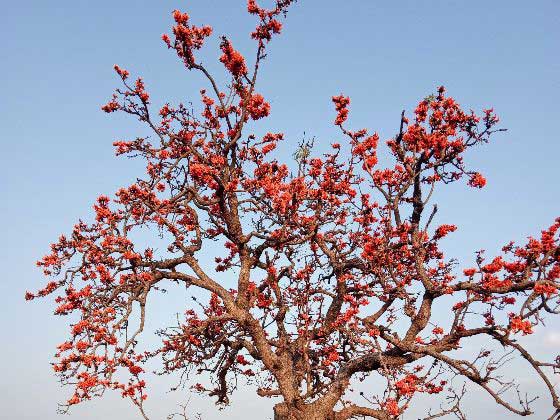
A palash tree in full bloom in the month of March. Photo by Digjoy Paul
Individuals:
Aastha Ashok (2), Abhimanyu Singh Baghel (1), Abhisheka Krishnagopal (43), Abinandhan (1), Able Lawrence (6), Adithya (2), Ajay (4), Akshada Potghan (1), Anagh (1), Anisha Jayadevan (3), Anupa K Babu (4), Arati Halbe (1) Aravind P S (1), Ashish Eradath (11), Ashok (4), Asish (1), Badri Narayanan Thiagarajan (4), Bhushan Shigwan (1), Chandra Sekhar Bandi (1), Digjoy Paul (1), Dr.P U Priyanka (475), Edurafi (1), FES Bichhiya (SHT Mandla) (126), Foolchand Kasde (6), Gayathri V Nair (2), Geetha Ramaswami (64), Girijakshan. T V (4), Hari Haran P (15), Hemraj P Patil (1), Janaki Lenin (50) Jaya Rakesh (13), Jisha K N (106), K S Lyla (289), Kedar (31), Lakshmikant Neve (19), Malaramuthan Rajamoni (38), Maya P V (3), Naamebankhraw Lyngkhoi (6), P S Baiju (48), P Rajangam (374), Pooja B Malaviya (1), Pooja Pawar (8), Prabhakaran P V (350), Prachi Thatte (6), Rama (31), Ramya (16), Reena s (1), Roshni Ravi (3), Rudra Prasad Banerjee (1), Sahana M (6), Saniya Chaplod (3), Sarath C (21), Selvaganesh (2), Shraddha (1), Siddharth Agarwal (5), Sindhu M S (3), Sriram (1), Stella (2), Suhel Quader (43), Sujatha M (1), Sukumar S (6), Surendhar Boobalan (188), Swathi (2), Swati Kittur (57), Swati Sidhu (29), Swetashree Purohit (1), Thryambak Sha (131), Tia (5), Vena Kapoor (5), Venetia Sharanya (1), Vignesh, M (1), Vinits Sangwan (19)
Species phenology
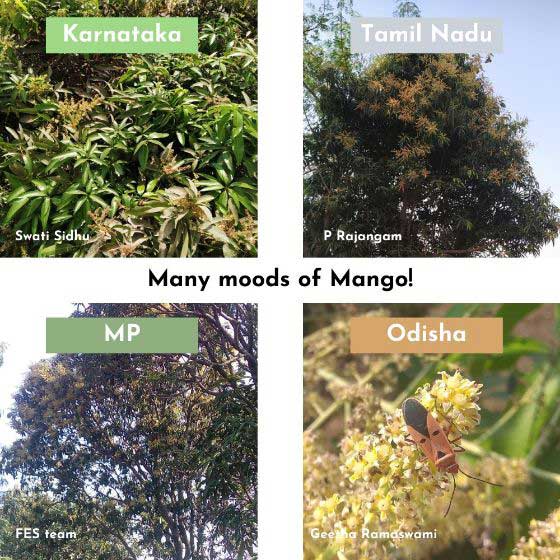
Mango was a favourite as always among SeasonWatchers. Here a post from Twitter by photos contributed by different observers.
We looked at flowering pattern in some of the most commonly observed species with 100 or more observations and plotted these on the country map below. For each of these species, we show the flowering pattern among the monitored trees from week 7 to week 13 this year. All trees monitored overall (grey), trees monitored in a week (pink), trees flowering in a week (purple) are shown. For the sake of these maps, we consider week 7 and 8 in February and week 9 to 13 in March.
Mango
Mango is a very widespread species and the map below shows the location of all the trees that were observed and those that were flowering in each week from week 7 to week 13 during the Festival in February and March. All trees observed during the period are also represented. Flowering seems to be maximum during end of February to early March, and decreases thereafter. This fits with the peak flowering pattern in this species (using our long-term data) that is quickly followed by fruiting in the Summer months.
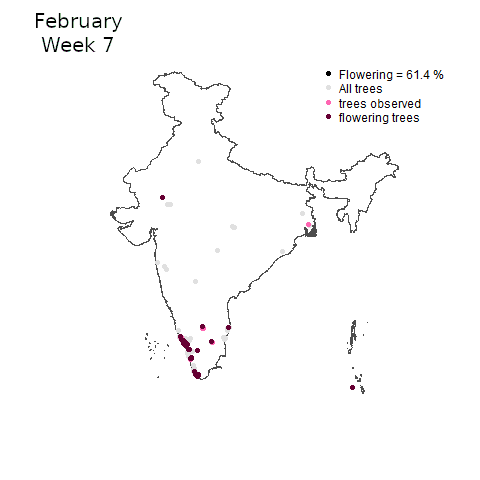
Neem
Another commonly observed widespread species during the Festival was the Neem. The species has a special cultural significance in Karnataka in March, the month of Ugadi, the new year festival in the state. The flowers of neem are used to cook Ugadi pachadi during the celebrations. Flowering peaked in week 12, just a week before Ugadi.
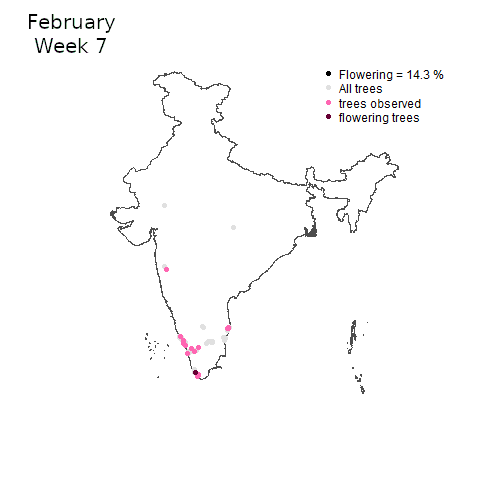
Rain Tree
Umbrella-shaped rain tree is a common avenue tree in Indian cities. The tree has lovely pinkish flowers that are present on the tree for several months, first between March and May, and then again later in the year. True to this, during most weeks, several trees (>70%) were flowering.
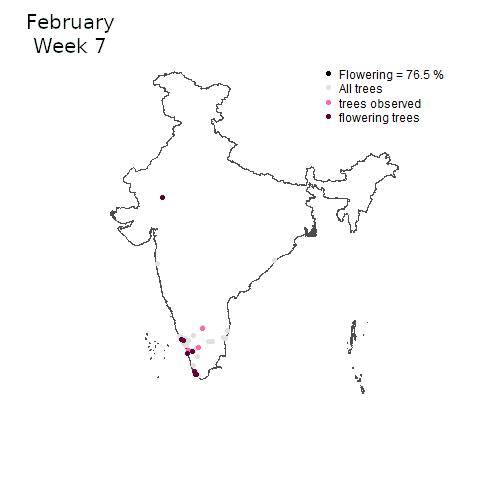
Indian Laburnum
Not one of our most commonly observed species, Indian laburnum (other common names – Kanikonna, Amaltas, golden showers tree) is quite a sight to behold when in flower. Several trees were observed to be flowering with a consistent increase in flowering trees from week 7 to week 12. In the last week a dip in flowering was observed. Since, Vishu is coming up soon, it will be interesting to see what percentage of trees will be flowering in the third week of April.
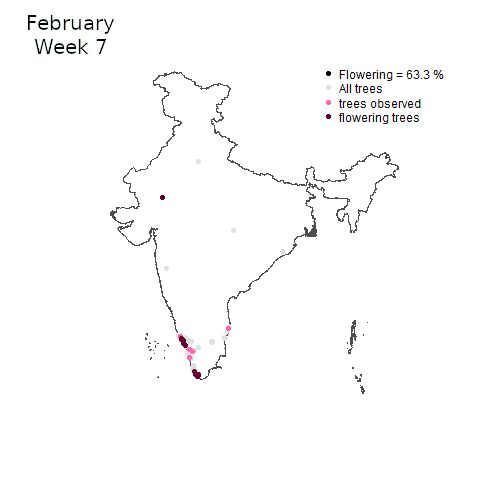
SeasonWatch on Youtube
We now have a YouTube channel. We are posting videos related to trees and SeasonWatch including this song on identifying some common trees using leaves and barks. Please subscribe to our channel if you would like to get updates. Thanks!
Write to us!
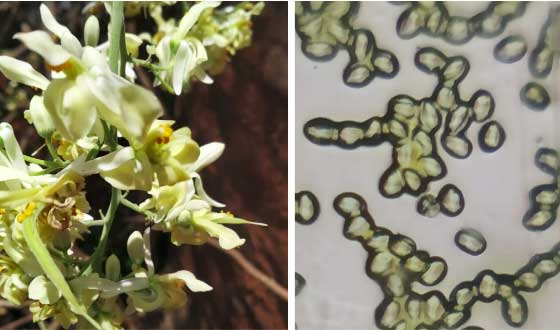
Drumstick (Moringa oleifera) flowers and pollen (as seen through a foldscope). Photos by P. Rajangam.
Would you like to see any other kinds of summaries of the data you have contributed? Do you have queries about the data you collected, the SeasonWatch app or trees in general? Send us an email at sw@seasonwatch.in or a WhatsApp message at +91 73495 67602. You can send us queries and suggestions on these contacts too!





